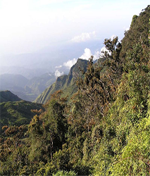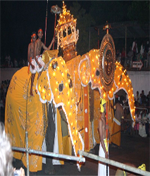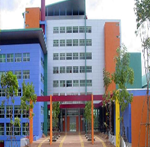In ancient times, Sri Lanka was known by a variety of names: Known in India as Lanka or Singhala, ancient Greek geographers called it Taprobane (play /t?'pr?b?ni?/) and Arabs referred to it as Serendib (the origin of the word "serendipity"). Ceilão was the name given to Sri Lanka by the Portuguese when they arrived in 1505, which was transliterated into English as Ceylon. As a British crown colony, the island was known as Ceylon, and achieved independence under the name Dominion of Ceylon in 1948.

The mountains and the southwestern part of the country, known as the "wet zone", receive ample rainfall at an average of 2,500 mm (98 in). Most of the east, southeast, and northern parts of the country comprise the "dry zone", which receives between 1,200 mm (47 in) and 1,900 mm (75 in) of rain annually. Much of the rain in these areas falls from October to January; during the rest of the year there is very little precipitation. The arid northwest and southeast coasts receive the least amount of rain at 600 mm (24 in) to 1,200 mm (47 in) per year.
The national flower of Sri Lanka is the Nymphaea stellata (Sinhalese Nil Mahanel),[25] the national tree is the Ironwood (Sinhalese Na),[26] and the national bird is the Sri Lanka Junglefowl, which is endemic to the country.

Most Sri Lankan cities and towns are connected by the Sri Lanka Railways, the state-run national railway operator. The first railway line was inaugurated on 26 April 1867, linking Colombo with Kandy. The total length of Sri Lankan roads exceeds 11,000 kilometres (6,840 mi), with a vast majority of them being paved.
The government has launched several highway projects to bolster the economy and national transport system, including the Colombo-Katunayake Expressway, the Colombo-Kandy (Kadugannawa) Expressway, the Colombo-Padeniya Expressway and the Outer Circular Highway to ease Colombo's traffic congestion. There are also plans to build a major bridge connecting Jaffna to the Indian city of Chennai.

Every year on or about 13 April Sinhala and Tamil people celebrate Sinhalese and Tamil New Year Festival, and Muslims celebrate Ramadan. Esala Perahera (A-suh-luh peh-ruh-ha-ruh) is the grand festival of Esala held in Sri Lanka. It is very grand with elegant costumes. Happening in July or August in Kandy, it has become a unique symbol of Sri Lanka. It is a Buddhist festival consisting of dances and richly decorated elephants.
There are fire-dances, whip-dances, Kandian dances and various other cultural dances. The elephants are usually adorned with lavish garments. The festival ends with the traditional 'diya-kepeema'. The elephant is paraded around the city bearing the tooth of Buddha. However the new year for tamils have been established as being on 14 January from this year.

With a literacy rate of 92%, and 83% of the total population having had Secondary Education,[69] Sri Lanka has one of the most literate populations amongst developing nations.[70] An education system which dictates 9 years of Compulsory Schooling for every child is in place, with 99% of the children entering the first grade.[69] A free education system initiated in 1945[71] by Dr. C. W. W. Kannangara, a former minister of education, has greatly contributed to this.
Chitragupta Tours Pvt. Ltd
SH-8/3-A-I-K,
Shivpur Bypass
Behind Lord Budha Public School.
Shivpur, Varanasi-221003, (UP)-INDIA
![]() +91-9936188440, +91-9140245699
+91-9936188440, +91-9140245699
+91-9936188441
![]() info@chitraguptatours.in,
info@chitraguptatours.in,
![]() www.chitraguptatours.in
www.chitraguptatours.in